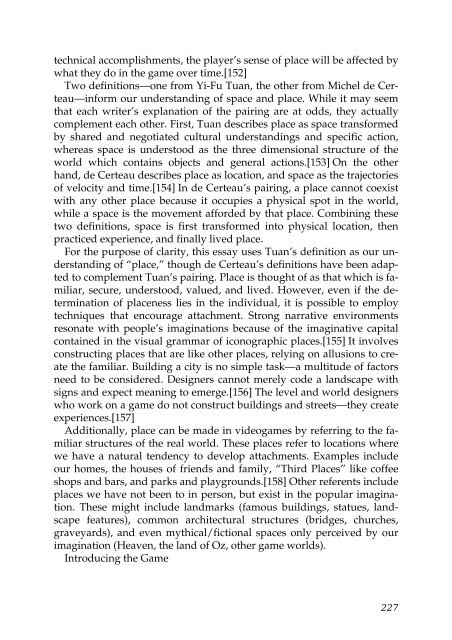Well Played 2.0: Video Games, Value and Meaning - OpenLibra
Well Played 2.0: Video Games, Value and Meaning - OpenLibra
Well Played 2.0: Video Games, Value and Meaning - OpenLibra
Create successful ePaper yourself
Turn your PDF publications into a flip-book with our unique Google optimized e-Paper software.
technical accomplishments, the player’s sense of place will be affected by<br />
what they do in the game over time.[152]<br />
Two definitions—one from Yi-Fu Tuan, the other from Michel de Certeau—inform<br />
our underst<strong>and</strong>ing of space <strong>and</strong> place. While it may seem<br />
that each writer’s explanation of the pairing are at odds, they actually<br />
complement each other. First, Tuan describes place as space transformed<br />
by shared <strong>and</strong> negotiated cultural underst<strong>and</strong>ings <strong>and</strong> specific action,<br />
whereas space is understood as the three dimensional structure of the<br />
world which contains objects <strong>and</strong> general actions.[153] On the other<br />
h<strong>and</strong>, de Certeau describes place as location, <strong>and</strong> space as the trajectories<br />
of velocity <strong>and</strong> time.[154] In de Certeau’s pairing, a place cannot coexist<br />
with any other place because it occupies a physical spot in the world,<br />
while a space is the movement afforded by that place. Combining these<br />
two definitions, space is first transformed into physical location, then<br />
practiced experience, <strong>and</strong> finally lived place.<br />
For the purpose of clarity, this essay uses Tuan’s definition as our underst<strong>and</strong>ing<br />
of “place,” though de Certeau’s definitions have been adapted<br />
to complement Tuan’s pairing. Place is thought of as that which is familiar,<br />
secure, understood, valued, <strong>and</strong> lived. However, even if the determination<br />
of placeness lies in the individual, it is possible to employ<br />
techniques that encourage attachment. Strong narrative environments<br />
resonate with people’s imaginations because of the imaginative capital<br />
contained in the visual grammar of iconographic places.[155] It involves<br />
constructing places that are like other places, relying on allusions to create<br />
the familiar. Building a city is no simple task—a multitude of factors<br />
need to be considered. Designers cannot merely code a l<strong>and</strong>scape with<br />
signs <strong>and</strong> expect meaning to emerge.[156] The level <strong>and</strong> world designers<br />
who work on a game do not construct buildings <strong>and</strong> streets—they create<br />
experiences.[157]<br />
Additionally, place can be made in videogames by referring to the familiar<br />
structures of the real world. These places refer to locations where<br />
we have a natural tendency to develop attachments. Examples include<br />
our homes, the houses of friends <strong>and</strong> family, “Third Places” like coffee<br />
shops <strong>and</strong> bars, <strong>and</strong> parks <strong>and</strong> playgrounds.[158] Other referents include<br />
places we have not been to in person, but exist in the popular imagination.<br />
These might include l<strong>and</strong>marks (famous buildings, statues, l<strong>and</strong>scape<br />
features), common architectural structures (bridges, churches,<br />
graveyards), <strong>and</strong> even mythical/fictional spaces only perceived by our<br />
imagination (Heaven, the l<strong>and</strong> of Oz, other game worlds).<br />
Introducing the Game<br />
227

















